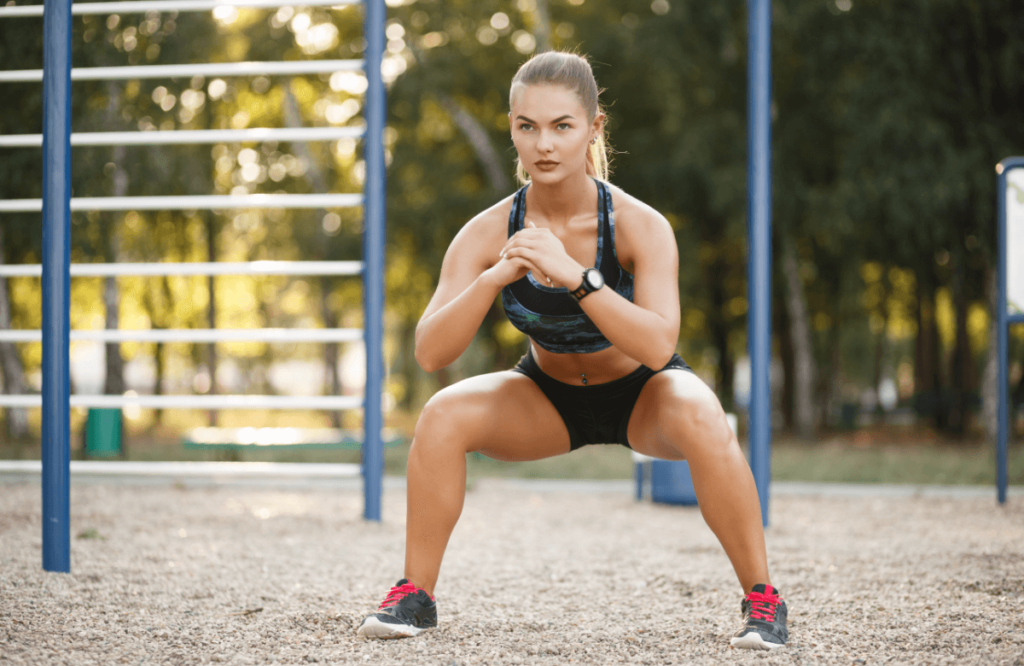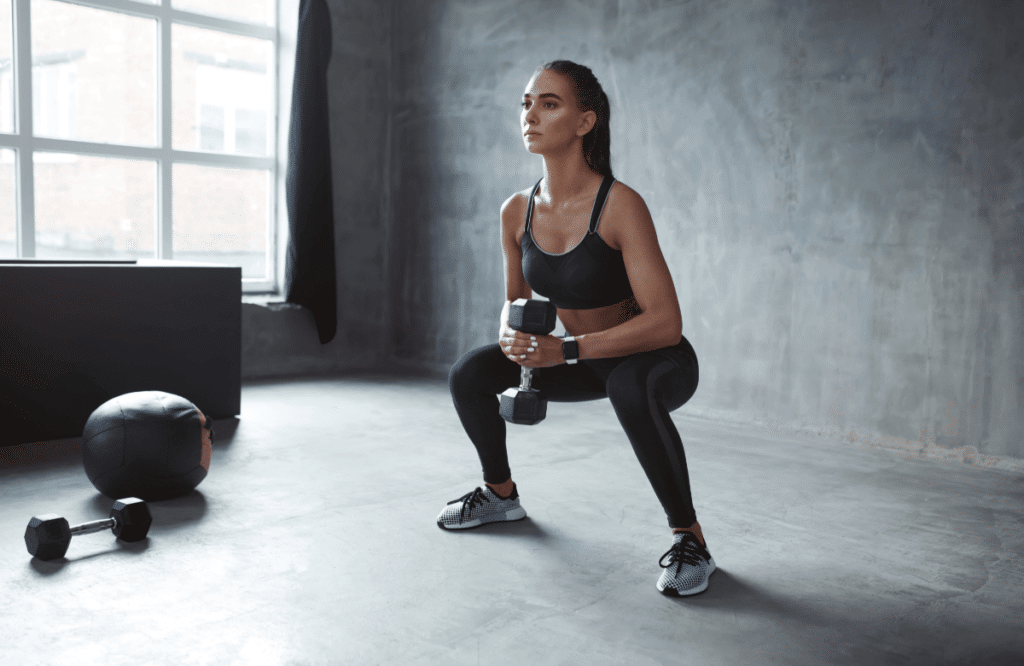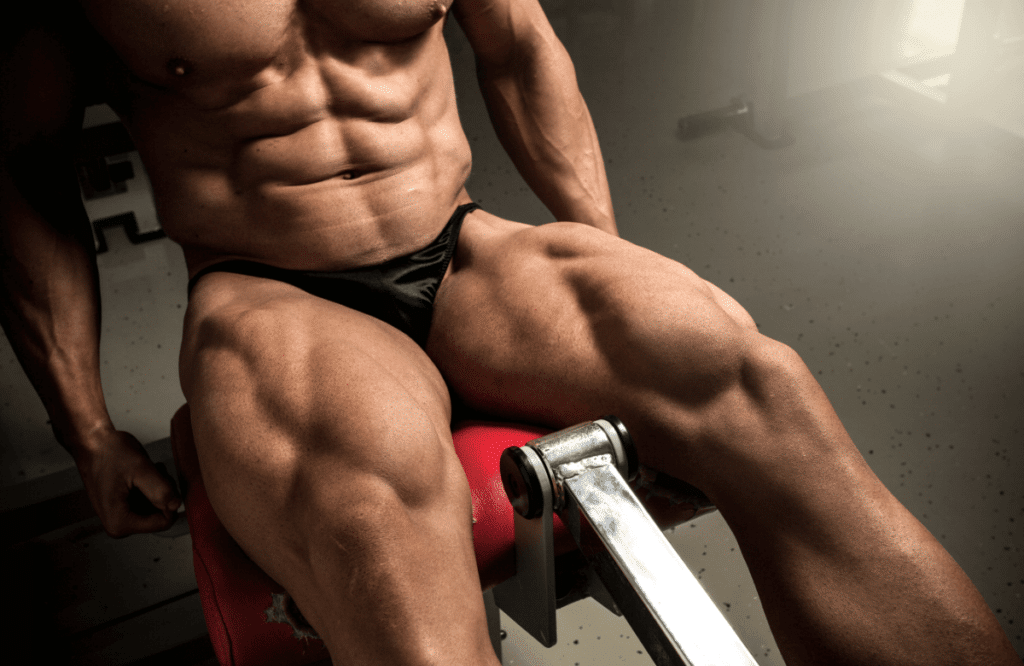Seeking a workout upgrade? The squat is one of the best exercises you can do to build muscle mass and strength in your lower body. And the sumo squat is a regular squat variation that hits the muscles a bit differently, and it’s worth adding to your training program for a powerful lower body.
Jump to:
- What is a Sumo Squat?
- Sumo Squat: Muscles Worked
- Traditional Squats vs. Sumo Squats: What Are the Changes in Muscle Activation?
- Do Sumo Squats Reduce Knee Stress More Than Other Squats?
- Sumo Squat Alternatives: Muscles Worked & How It Changes
- Sumo Squat Mistakes to Avoid for Max Muscle Engagement
- Benefits of a Sumo Squat
What is a Sumo Squat?
A sumo squat is a compound exercise that’s a variation of a regular squat, with a wider stance than the normal squat. Whereas you would stand with your feet roughly shoulder-width apart on a traditional squat, you’ll widen your stance and turn your toes outward a little for a sumo squat.
You can do a barbell sumo squat, dumbbell sumo squat, or even use kettlebells, the smith machine, a sandbag, or even just your body weight.
Sumo Squat: Muscles Worked
The biggest advantage to this type of squat is that it works more muscles than the regular squat movement. Here’s what you’ll be working when you choose to squat with your feet wider than usual.
Primary Muscle Groups Targeted
Like conventional squats, the sumo squat places emphasis on the quadriceps and the glute muscles. But the wide stance sumo squat also catches the adductor muscles — a group of muscles on the inside of the thigh.
Secondary Muscle Groups Worked
The sumo squat also works the hamstrings, hip flexors, and calves, and of course, you’ll need to keep your core tight as you squat, building core strength.
Traditional Squats vs. Sumo Squats: What Are the Changes in Muscle Activation?
While both the sumo squat and the traditional squat work the lower body muscles and look very similar, there are some specific differences in muscle activation.
From the starting position, you’ll tighten the core muscles just as you’re about to squat. This is the same for all squat variations! From the squat stance, you’ll begin to bend your knees and lower yourself down into the squat position.
Here, the knee flexors and ankle flexors kick in to lower you down. The glutes and quads also activate on the downward movement, to control your descent and prevent you from dropping too quickly.
The adductors, abductors, and hip flexors also come into play here to hold your legs in place as you squat. But once you’re at the bottom of the squat, this is where the biggest muscle activation differences happen.
In a regular squat, the quads and glutes tend to be the driving force behind pushing you back up. But when you’re in a wide-stance squat, the adductors come into play in a bigger way, essentially flexing harder to bring your legs towards each other and initiate upward movement.
The glutes also work a little harder during the sumo squat ascent, so you’ll get a bit more glute activation on this variation than the standard squat. And of course, the quads still play their part, but you’ll definitely feel the difference in which muscles really work hard!
Do Sumo Squats Reduce Knee Stress More Than Other Squats?

Squats with a narrow stance have been shown to increase knee movement in the frontal plane, which means there’s more risk of injury to your knee. This is especially true if your knee’s stabilizing muscles aren’t strong yet.
Conversely, wide-stance squats tend to keep the knee in position, which can be beneficial for those with weak knees. However, it’s important to note that there’s more to it than simply your foot stance—the angle at which you place your feet also plays a role.
This study shows that the greater the angle of your feet, the more rotation you can expect in your knee and hip joints. This could quickly cause injury, especially if you’re lifting heavy with a barbell.
The scientific evidence points to a wider stance, moderate foot angle position for reduced knee strain. Based on this, we can safely say that sumo squats are great for less knee strain, as long as they’re paired with a moderate foot angle.
Sumo Squat Alternatives: Muscles Worked & How It Changes
Unsure of the sumo squat? Here are some sumo squat alternatives and their various muscle activations to help you decide which one would work best for you.
Front Squat
Front squats engage the muscles of the front of the body more strongly, whereas sumo squats hit the posterior chain. You’ll get more quad and core activation, because the weight is loaded on the front of the body rather than the back.
You also need to remain a bit more upright than you would with a back-weighted squat, moving more vertically, which means the load is placed squarely on the quads and less on the hips and the spine.
There’s also some upper body muscle activation here, as your chest, biceps, and shoulders need to hold the weight in position and prevent it falling forward.
Cossack Squat
The cossack squat is a single-leg squat variation that’s considered an advanced variation. It’s also done with a wide stance, but instead of lowering yourself straight down with equal weight on each leg, you shift your weight over each leg, one at a time, and squat with that leg while keeping the other one straight and out to the side.
Like all squats, the cossack squat places a load on the quadriceps and glutes and makes them work hard to push you out of the squat. The hamstrings and hip adductors on the non-squatting leg get a great stretch and are trained eccentrically during this movement.
To keep your torso upright and prevent it from twisting during this movement, the obliques also come into play more than they do on other squats. It’s worth noting that the cossack squat won’t be performed with as much weight as others, if it’s done weighted at all.
Goblet Squat
The goblet squat is also typically performed with a wider stance, because at the bottom of the movement, you’ll need to fit your elbows between your knees to get the best range of motion.
It activates pretty much the same muscles as the squat and sumo squat do, depending on how wide a stance you choose. But you’ll also get strong core activation, thanks to the front-loaded nature of this variation.
Like the front squat, you’ll also get some upper body muscle activation, including the biceps, shoulders, lats, and traps.
Zercher Squat
The Zercher squat is another front-loaded variation that works your quads, hamstrings, and glutes just like other squats. But thanks to its unique way of holding the bar, it gets a good bit more upper body engagement than others.
The upper back muscles, lats, and traps need to activate to hold the weight in position, counterbalanced by the front delts, biceps, and forearms. And like all squats, there’s a fair bit of core muscle activation to keep you stable.
Plie Squat
The plie squat activates the muscles quite similarly to the sumo squat. The wide stance targets the adductors, making it an excellent choice for inner thigh activation. However, the plie squat should only be attempted if you’ve mastered the sumo squat and have no knee problems.
Sumo Squat Mistakes to Avoid for Max Muscle Engagement
While the sumo squat variation is a great one to have in your leg day repertoire, it’s important to do them properly to get the best benefit. Avoid these mistakes and you’ll be on the right track.
Not Widening Your Stance Enough
Using a wide stance is the key to doing a proper sumo squat. The wider you stand, the more your inner thighs and glutes engage. Make sure your foot position is wider than shoulder-width apart, and your toes should be turned out slightly.
If you don’t have knee problems, you can turn your feet out at whatever angle you’re comfortable. But keep in mind that the further out you turn your feet, the more risk there is for the knees to move out of position.
Using Too Much Weight
Whatever squat variation you’re doing, using too much weight will make it harder to keep your form. You should be able to do at least 4 reps with perfect form if you’re aiming for hypertrophy.
When you’re lifting too heavy, your body also engages other stabilizing muscles to help you lift, which takes away from the muscles you think you’re working. Here’s also a higher risk of injury if you’re squatting with heavier weights.
Squatting With Poor Form

Using poor form is the most common mistake in all squat variations. Here are the mistakes to avoid to make sure you’re always doing it with the proper technique.
Not Keeping a Straight Back
A straight back is essential for injury prevention and to maximize muscle engagement. Rounding your back places pressure on your spine and can cause back injuries. It’s a good idea to try squatting in front of a mirror so you can check if you’re keeping your spine neutral.
Not Engaging Your Core
Engaging your core helps to maintain a straight back, so these go hand in hand. Before squatting, breathe in and tighten your core before bending your knees. Forgetting to engage your core means you won’t have robust support for your back and it’ll be harder to maintain proper squat form.
Leaning Too Far Forward
You should be keeping your torso as straight as possible while squatting. If you’re not used to the wide stance, it can be easy to accidentally lean forward to balance yourself during the movement.
But leaning over instead of maintaining an upright position can place strain on your back, hips, and knees. It also makes it much more difficult to engage your abs.
Keep your weight centered over your heels and lift your chest. Also, keep your glutes “tucked” under, which will help you to maintain that important straight back without leaning forward.
Too Much Knee Movement
Although it’s easier for the knees to cave on a narrow stance squat, it can happen with the sumo squat. It’s most often a result of tight hips or weak glutes, so you can get around it by stretching your hips well before squatting and making sure you go easy on the weight.
Squatting Too Low
Even if you can squat deeply with your regular squat, start shallower when moving over to sumo squats. You can work your way to deeper and deeper sumo squats as you go. It’s also a big mistake to keep squatting low if you have pain in your knees or back when you do so. Rather squat shallower and build up strength until you can squat deeply without pain.
Benefits of a Sumo Squat

Sumo squats have a ton of benefits and it’s worth including them in your leg workout routine, along with your regular squats, or alternating between them workout by workout.
Improves Lower Body Strength
The sumo squat is a great strength builder. It recruits some of the biggest, most powerful muscles in the body, so by incorporating them regularly and with excellent form, you’ll notice an improvement in your lower body strength.
Builds Muscle Mass
Loading the leg muscles with the sumo squat not only builds strength, but helps to build muscle mass as well. You can build an impressive set of muscles in the upper legs and glutes especially.
Sculpts Aesthetic Legs
The addition of the adductors in the sumo squat movement allows you to really sculpt your legs. Targeting the adductors round out your leg muscles as they’re often neglected, so your leg muscles will be the envy of the town!

Improves Hip Mobility
Sumo squats are excellent for working the hip flexors, and thanks to the wider stance, they get a better stretch than the regular squat allows for. You can expect better hip mobility if you do the sumo squat consistently.
May Reduce Back Pain
The sumo squat requires a slightly different torso position to the traditional squat, standing more upright. This can help to reduce strain on the lower back during the movement, which can help ease lower back pain.
Strengthening the gluteal muscles can also fix a lot of lower back problems, especially for those who spend a lot of time sitting behind a desk for work. Inactive glutes can “switch off”, and sumo squats can switch them back on again.
Can Improve Balance
Between building stronger glutes and stronger inner thigh muscles, your balance should improve. Your adductors and glutes will be more inclined to kick in when you need balancing, distributing the weight across the lower body muscles more evenly.















